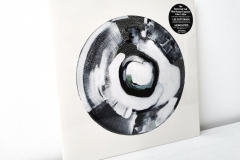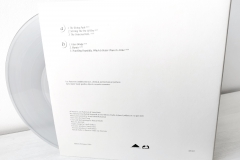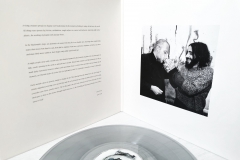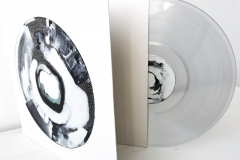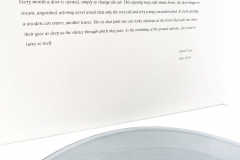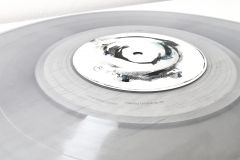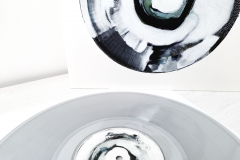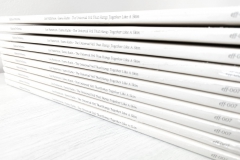Lee Patterson / Samo Kutin – The Universal Veil That Hangs Together Like A Skin
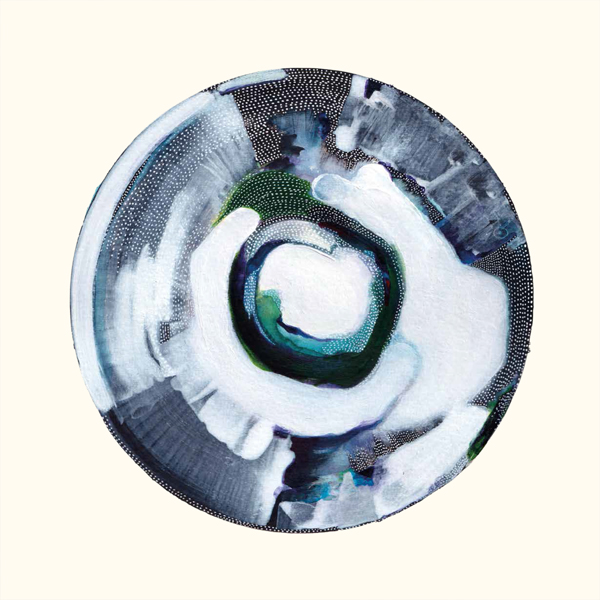
1. The Rising Path (6:47)
2. Stirring The Pot Of Fire (6:19)
3. The Universal Veil… (7:12)
4. Glass Bridge (3:12)
5. Mantis (6:39)
6. Travelling Hopefully, Which Is Better Than To Arrive (8:37)
· Lee Patterson: amplified devices, chemical and mechanical synthesis
· Samo Kutin: hurdy-gurdies, objects, acoustic resonators
All music by Lee Patterson & Samo Kutin
Recorded by Jernej Babnik Romaniuk at KUD Mreža’s Studio Asylum, Ljubljana on 1-2 April 2019
Mixed and mastered by Jernej Babnik Romaniuk
Liner notes by David Toop
Cover and label paintings by Rachael Elwell
Photo by Jan Prpič
Graphic design by László Szakács
Executive producer: Nataša Serec
Associate producer: László Juhász
Special thanks to Mauricio Valdés San Emeterio
A rising creature spreads its shadow over hushed land. In the moment of folding its wings, all air leaves the world. All things now operate by friction, stridulation, rough surfaces in contact with abrasion, materials unlike silk or plastic, the working of ground teeth and jaw bones.
In the blacksmith’s forge, an alchemist sits away from the fire in a clouded spot, observing those transforming states that move from hard to soft, from dull to radiant. From trees a presence emanates, as thick as wet moss and mud. Birds move within it, their shapes only visible with closed eyes.
At night, people sleep with covered ears, their dreams haunted by the footsteps of giants, the slow movement of hills, cracks opening in the earth to unleash insect clouds. Houses lack windows, yet light penetrates, if only to mark daily transitions between stillness and movement, heat to cold. If there are bells, they are heard only in memory, as if buried under silt on the bed of a fathomless pond. To sit quietly is rewarded. A shout is impossible.
Every month a door is opened, simply to change the air. This opening may take many hours, the door hinges resistant, anguished, uttering secret words that only the very old and very young can understand. At each opening, a wooden cart enters, another leaves. The ox that pulls one cart looks sideways at the horse that pulls the other, their gaze as deep as the silence through which they pass. As the trembling of the ground subsides, the world returns to itself.
David Toop
June 2020
Released: October 2020 / first edition of 300 lps & 300 cds
Direct purchase: Bandcamp / Discogs
GALLERY ↓
REVIEWS ↓
“Ustvarjalno sodelovanje Leeja Pattersona, rezidenčnega umetnika KUD-a Mreža, ter hurdy-gurdista in improvizatorja Sama Kutina lahko razumemo kot skupni preboj dveh veščih laborantov zvokov iz okolja, ki jim avtorja pridružujeta inštrumentalne. Tako Lee Patterson kot Samo Kutin se ne obotavljata iskati naprej, iščeta nove spoje zvočnih virov ter brišeta meje med inštrumentalnim in naravnim ali umetnim zvokom, uporabljata jih kot vir inspiracije in ustvarjata trenutke, v katerih se naključno druži z iskanim.
Če se Kutin pri tem vrača k svojemu izbranemu inštrumentu hurdy-gurdyu, je Patterson bolj disperzen in raziskuje v več smereh. Pri tem je bistveno, da se ne čutita omejena, marveč prisluškujeta različnim šumom, pokom in drugim zvokom, ki jih družita na vedno nov in neponovljiv način. Plošča The Universal Veil That Hangs Together Like A Skin je dobrodošla za vse ljubitelje zvočnih okušanj in raziskovanj. Lee Patterson je znan po rabi ozvočenih predmetov in postopkov, zato nam je njegovo ustvarjalno druženje s Samom Kutinom ljubo, saj oba izhajata iz tendenc po novem, po presenečenjih in nepričakovanih interakcijah. Sobivanje ali mehko konfrontiranje posameznih zvočil med seboj povzroča vedno nove zvočne svetove kot sinteze druženja šumov, pokov, zvenov…
Skladba The Universal Veil je eksperimentalno zvočenje, ponavljajoč se vzorec z nekaj spremembami, ki pa ne vplivajo na potek in ritem dela. Spremljajoči šumi, trki, pokljanje razbijajo linearnost melodičnega zvoka in mu dajejo poseben akcent. Glass Bridge zveni kot gašperček in curljanje vode hkrati, ki ustvarjata zvočni kontekst, ob zvoku nekakšnega trobila. Mehko sozvočje vseh zvokov se izpoje v inštrumentalni solo in se zaključi kot neke vrste zvočna alkimija. Mantis spominja na pravo zvočno škržatenje in klopotanje ter udarjanje po kovini. Vsi ti zvoki se izmenično ujemajo v umirjen zvočni krogotok, v katerem lahko spremljamo zvoke kot celoto ali pa jih raziskujemo posamič. The Rising Path je najbolj monokromna skladba. Zvok hurdy-gurdya ustvarja utečeno osnovo, ob kateri vzporedno potekajo drugi linearni zvoki. Celota nekoliko spominja na abstrahirano minimalistično glasbo. Travelling Hopefully, Which Is Better Than To Arrive nas spomni na parnik, ki trobi, ko zapušča pristanišče. Iz začetnih signalov se vzpostavi kontinuirani zvočni tok, ki deluje industrijsko opresivno, hkrati pa nas utiri v notranjost zvočnega toka, da mu prisluhnemo in sledimo njegovemu razvoju. Masa zvočnih impulzov se napaja z lastno energijo in si z minimalnimi transformacijami odpira pot v čas in prostor, zajame nas in nas v celoti prežame s specifičnim vzdušjem.
Glede na to, da sta umetnika profilirana improvizatorja in zvočna raziskovalca, lahko rečemo, da je rezultat njunega skupnega udejstvovanja izvirno zvočno zorenje, ki se odraža v raznolikih skladbah, v katerih zasledimo razpon od improvizacije do zvočnih poskusov in druženja posameznih zvočnih entitet. Zato sta zgoščenka in LP dobrodošla zlasti za tiste poslušalce, ki tako druženje cenijo in zmorejo spontano slediti osvobajajočim novim zvočnim paralelnim svetovom.” / Marina B. Žlender, SIGIC – Odzven, 26 October 2020
“Sama Kutina najbolje poznamo kot tretjino ustroja domače zasedbe »namišljenega folka« Širom, vendar to še zdaleč ni edini ventil njegovih glasbenih pajdašenj. Tokrat v navezi s priznanim zvočnim raziskovalcem Leejem Pattersonom ohlapno, prosto, dromljajoče, zračno, minimalistično, čudaško, ambientalno in komaj kdaj ritmično vleče počasne odtenke elektroakustike. To je glasba, ki ni zares glasba, ampak bolj improvizacija v nizih oglašanja virov zvoka in počasnem razvoju tonov. Album, na katerem so tehnike ozvočevanja in ojačevanja pomembnejše od kompozicije. Gvišno povsem nišno.” / Borka, Mladina, 30 October 2020
“Only an authentically experimental approach to musical instruments and, more generally, to the means of sound production can allow us to overcome or even elude their universally recognized identity, the experiential and synaesthetic memory connected to them. And it’s only after having established such a relationship of ingenuous and ingenious curiosity that the audio document can authentically return to be an acousmatic device, the place of a complete and unfathomable abstraction aimed at fraying, as far as possible, any tie with the mimesis of the real.
In this sense, the improvised session by Lee Patterson and Samo Kutin is a formidable act of sonic dissimulation, the intransigent exercise of an expressive tabula rasa whose discrete elements, even if detectable in nature, could hardly be reproduced except in its serendipitous and epiphanic encounter through experimental manipulation. The advantage of the unprecedented English-Slovenian duo is undoubtedly the use of an uncommon and heterodox instrumentation which over time has respectively forged their distinctive features.
Patterson, poet of the inaudible, investigates the acoustic potential of places and the objects that inhabit them, using a wide range of contact microphones, hydrophones, and amplified devices on which he acts manually or by breath. Kutin, on the other hand, has dismembered the wooden body of the hurdy-gurdy to transform it, in parallel with the operation of the crank, into a working table of ever-new preparations and material interactions.
This sort of framework can therefore disclose infinite executional variations while, once filtered into the audio medium, retaining the secret of their concrete origin, clearing the field of imagination for the listener who may be more or less informed about the recording’s practical preconditions. That said, much of the vigorous resonance is probably attributable to Kutin’s chordophone which, amidst rough metallic frictions and delicate juxtapositions of other apparatuses, is able to embrace a timbral variety that extends from a vibrant monodic chant to the most piercing screeching.
Even with such a stimulating potential at hand, the duo maintains a coherent stylistic balance, relating on the level of a drone music rich in spontaneous microtonal inflections, labored heaves and sinister industrial clangs: a sample of fleeting presences and acoustic veinings in filigree to an amorphous but incredibly tangible scenario, aided by the cobbling, chirping and bubbling through which Patterson outlines his own eccentric elemental synthesis.
The Universal Veil That Hangs Together Like A Skin is a subtle and penetrating surge of sonic otherness, the visionary and happily unclassifiable outcome of an alliance based on the ability and sensitivity of listening beyond contingent reality to tune in to the unstable frequencies of the possible. It is starting from these coordinates that, at the end of the golden age of pure electronics, the art of soundscaping may be re-founded.” / Michele Palozzo, Esoteros, 4 November 2020
“Samo Kutin woont in Ljubljana en bespeelt de draailier op een tamelijk ongewone manier – hij onderzoekt alle mogelijkheden van het instrument en zoekt daarmee de grenzen van de muzikale mogelijkheden duidelijk op. We kenden hem ook al van de ongewone folkband Širom waarin hij overigens nog heel wat meer instrumenten bespeelde.
Lee Patterson woont in Manchester en maakt experimentele muziekinstrumenten, waarmee hij geluiden produceert die op zijn zachtst gezegd ongewoon klinken.
Deze twee muzikale avonturiers hebben elkaar gevonden en samen een uniek album opgenomen waar ik met open mond naar heb zitten luisteren. In twee dagen tijd opgenomen in een studio in Ljubljana op 1 en 2 april 2019. Geluiden op de grens van muziek. Aftasten, wanneer zijn het geluiden die gewoon interessant of fascinerend zijn en wanneer wordt het muziek? Doe dat er nog toe als je merkt dat je geïntrigeerd zit te luisteren?
Muziek die je als luisteraar scherp houdt, daar hou ik wel van, en dat doet deze muziek zeker. Niet voor luie luisteraars.” / Holly Moors, Moors Magazine, 5 November 2020
“Non è nuovo su queste pagine Samo Kutin che avevamo apprezzato con A UniverseThatRoastsBlossoms For A Horse, pubblicato dal suo gruppo, il trio sloveno dei Širom. Questa volta oltre ai soliti risuonatori acustici che lo accompagnano in tutti i suoi progetti, Kutin è affiancato dal musicista e sound artist inglese Lee Patterson.The Universal Veil That HangsTogether Like A Skin è il risultato di questo incontro che si materializza in sei tracce materiche e amorfe pubblicate da Inexhaustible Editions / Edition FriForma.
Patterson scolpisce la materia sonora avvalendosi di microfoni e oggetti di uso quotidiano indagandone il potenziale mentre Kutin con la ghironda modificata imbastisce trame sonore dense e avvolgenti.
Le sei tracce di questo progetto sono spazi aperti nei quali i due musicisti fanno dialogare i loro strumenti inusuali ottenendo un suono monolitico che scava nell’essenza dello strumento e del gesto, in cui l’improvvisazione diventa un rito moderno.
The Rising Path suona come una sega circolare, una traccia di drone music aspra e corposa contornata da elementi industriali. Un suono potente e magnetico tale da sfruttare il luogo circostante come cassa di risonanza. Con Stirring The Pot Of Fire il duo indaga le possibilità timbriche degli strumenti a partire dai suoni stridenti e metallici dei cordofoni di Kutin. Con la seconda traccia non è più il luogo a influenzare il suono, ma il gesto: la ripetizione rende la traccia piena e corposa per quella che risulta una miscela di acusmatica e fonetica. I dueampliano lo studio delle risonanze con Glass Bridge ponendole in relazione ai frammenti vetrosi usati come parte ritmica. Intensi feedback risuonano in Travelling Hopefully, Which Is BetterThan To Arrivemanipolati a suon di sintesi elementale fino a generare un suono materico stridente e dal sapore industriale che riproduce il suono di un treno in movimento.
The Universal Veil That Hangs Together Like A Skin è un lavoro complesso che indaga il potenziale degli strumenti in relazione al luogo e del luogo in relazione agli strumenti. Il duo anglo sloveno si relaziona e si scontra a colpi di suoni, così come succede per gli oggetti e i luoghi che vengono interconnessi tra loro.” / Mario Ariano, Radioaktiv, 15 November 2020
“Glasba s plošče, ki ji ta večer namenjamo čas Tolpe bumov, v vsej svoji snovni drobljivosti, organskem veličastju in sveti premišljenosti razprostre neko bivanje in težak zrak v meglicah na obzorju. Njena govorica je skoraj neznatna, prežita, njena tišina je molk, njen hrup oddaljen, pripovedovalec sinestet. Manchestrska veličina eksperimentalne, raziskovalne in improvizirane glasbe Lee Patterson in domači znanec Samo Kutin pričata o pregibanju odtenkov in zvena, o materialu in njegovi rabi, o neki fantazmi in njeni postavi.
The Universal Veil That Hangs Together Like A Skin je plošča scenografsko doživete, skoraj pripovedne glasbe, zaigrane na izredno osebne nabore inštrumentov, s katerimi sta oba glasbenika že oblikovala lastne govorice, skupaj pa sta takšne govorice zmožna načrtovano, preudarjeno zrcaliti drug ob drugega ter tisto – v procesu postalo – tolmačiti v goste sežetke fantastičnih gmotnih pejsažev. Pršice v sapi, drhtenje in sršenje, klokot, upor, ritual, obred, napetost, statika. Šelestenje, nadzorovano izgorevanje, praskanje s krilci in nožicami, trkljanje v suspenzu prostorov, izpraznjenih šepeta. Izustenje, vendar ne iz ust. Pomembni britanski kritik in teoretik David Toop v spremni besedi orisuje v nebo vzdigujoče se bitje, ko zloži krila in s tem podnje vpotegne vso atmosfero dežele.
Glasbenika v procesu izvedbe vizualno močno izzivalnih miniatur tolmačita svojim materialom vpisane nezveznosti, vdore, razmaknjenosti in pripetljaje ter jih pregibata, zlagata, po izumljenih logikah lastnih ustvarjalskih, glasbenih metod v morda materialno krhke, a fantazmatsko mogočne prežitke inštrumentalne prakse in poslušanja snovi. Patterson se jasno prepušča nareku, naravi materialnih principov, slišnih scen, kulis, dogodkov v trajanju oziroma, kot to opredeli sam – izziva slišne okruške kemične in mehanične sinteze ter ozvočuje pogosto neopažene draži predmetov. Generira, vzbuja, misli prisluhe človeku nemim okoljem, vzgibom, volji. Kutin na drugi strani oblikuje posege v zven, materiale same, tako snovne kot glasbene, spominske, tradicijske. Razgalja jih in uteleša, prevaja njihovo drhtenje in upore v vrste refleksivnih nizov slišnih preslikav. Plošča The Universal Veil That Hangs Together Like A Skin pa morda vse njuno raznoliko mimobežno delo združi in osmisli osredotočeno ter dosledno, oba glasbenika resnično prikaže, o njiju in njuni moči trobi izza tančice tenkočutno oblikovane, prelepe diskografske izdaje.
Fantazme plošče smo že nizali in dražili, vendar je v gmotni veličini, v skoraj masivnih podobah, s katerimi se predočajo, tudi nekaj izrazito neizrekljivega, nezveznega, umaknjenega, umolklega in zakritega. Morda mehanizmi takšne postopnosti, rezov v pregledno s poslušalčeve perspektive delujejo kot nekaj enostavnega, plošča je v določenem smislu vsekakor tudi minimalističen, preprost niz diskretnih vtisov. Vendar še pred temi vtisi, svet, ki ga vzbuja, ujame med dlani, vsebuje tudi gon, ki izvira iz prakse previdne improvizacije, pozornosti, etičnega odnosa do okolja in sega onkraj mešetarjenja ali tope fascinacije, zgolj drobljenja, zrnjenja, vodenenja, vsega posameznega, kar slišimo. Morda zgolj gon po preživetju, trzanje, umik pred sublimno podobo zunanjosti.
The Universal Veil That Hangs Together Like A Skin je plošča resnično vrhunskega, svetovnega formata, ki je izšla pri domači enoti FriForma Editions, podenoti mednarodno postavljene založbe Inexhaustible Editions, ki deluje v Ljubljani pod vodstvom Lászla Juhásza. Razdelek FriForme, ki se razrašča iz tukajšnje promotorske aktivnosti založbenih protagonistov, pa vodi Nataša Serec, dolgoletna pobudnica glasbene in širše umetniške ustvarjalnosti v teh krajih. Tudi ta plošča mora biti poklon in priznanje njuni kontinuirani, vztrajni dejavnosti. Morda ključne pa so tudi okoliščine rezidence na pobudo Serec oziroma KUD-a Mreža, v okviru katere sta Lee in Samo snovala ter snemala v Ljubljani, v Studiu Azil z Jernejem Babnikom Romaniukom, čigar prispevek k zvenskemu razkošju plošče nikakor ni zanemarljiv.” / Žiga Pucelj, Radio Študent, 6 December 2020
“Добротный электроакустический импров от неожиданного дуэта. Редко выпускающийся англичанин Ли Паттерсон на своём столе имеет кучу подзвученных объектов, запуская какие-то звучащие химические и механические процессы. Активный в последние годы словенец Само Кутин играет на колёсной лире (хурдигурди) с объектами и акустическими резонаторами. Музыка по большей части тягуче-дроновая: Кутин наслаждается обертонами своего инструмента, Паттерсон раскрашивает поверх мелкими звучаниями, по которым я как раз и соскучился.” / Илья Белоруков, Telegram, 4 January 2021
“A poco più di un anno dalla pubblicazione di ‘A Universe That Roasts Blossoms for a Horse’ con i suoi Širom, è tornato il musicista sloveno Samo Kutin, questa volta in compagnia del musicista e sound artist inglese Lee Patterson, con un album di sei brani intitolato ‘The Universal Veil That Hangs Together Like A Skin’. L’artista inglese, per l’occasione, ha utilizzato microfoni e diversi oggetti di uso comune, mentre Kutin si è occupato di disegnare le trame su cui si è poi stagliato il lavoro di Patterson. Il risultato di questo sodalizio artistico è un disco nel quale i brani, più che avere una forma reale e compiuta, sono il mezzo attraverso il quale esplorare il potenziale di tutto ciò che è stato utilizzato come strumento. ‘The Rising Path’ è un lungo bordone, ‘Stirring The Pot Of Fire’ ha un suono decisamente meno denso, ma è centrale il lavoro dei cordofoni su tracce metalliche. L’esperienza di ‘The Universal Veil…’ ricorda vagamente quella dei Širom, mentre in ‘Glass Bridge’ i due musicisti ricorrono alle risonanze. ‘Mantis’ sembra suggerire addirittura qualche suono naturale, prima della chiusura con ‘Travelling Hopefully, Which Is Better Than To Arrive’, dove l’atmosfera si fa industriale. ‘The Universal Veil That Hangs Together Like A Skin’ è un lavoro decisamente complesso, che va necessariamente analizzato alla luce del suo fine ultimo: studiare le potenzialità sonore di strumenti non convenzionali. Accettata questa premessa, sarà più semplice innamorarsene.” / Piergiuseppe Lippolis, Music Map, 11 January 2021
“Edition Friforma is a sub-division of Inexhaustible Editions and I would assume with a name like that, friforma, freeform, this is all about improvised music. On this particular release, we find recordings made in Ljublana on 1 and 2 April 2019 by Lee Patterson (amplified devices, chemical and mechanical synthesis) and Samo Kutin (hurdy-gurdies, objects, acoustic resonators). It has been a long time since I heard anything from Lee Patterson (Vital Weekly 762, his trio with Rhodri Davies and David Toop) and from Kutin we reviewed some of his improvisational music in recent times. With their somewhat unusual instruments, they recorded six pieces of music, with some likewise unusual results. In terms of improvised music, this is something that operates at the intersection of drone music and electro-acoustic music, and not so much with some hectic, nervous scraping and scratching. It starts with the beautiful overtone piece of The Rising Path, static and majestic, ringing and singing. In Stirring The Pot Of Fire, bowing techniques are used and this is something less drone-based, but with all the minimal electro-acoustic sounds they use, it certainly has quite a mysterious character; it sounds as if one in a kitchen and various pots are brewing. That is something that returns in The Universal Veil…, even more, improvised or in Glass Bridge, which goes in an opposite direction, that of electro-acoustic music and musique concrète. I quite enjoy this sort of ‘swing’ in approaches by this duo. They don’t want to go one direction and explore all of that, but rather feel more comfortable in exploring many roads to the instruments they use. I would say that this gives them a lot of option for further exploration and in each of these pieces there an element of surprise, and it is a true delight to hear what they come up with.” / Frans de Waard, Vital Weekly, 27 April 2021
“Samo Kutin nous avait livré un véritable OVNI sonore l’année dernière en compagnie du saxophoniste Martin Küchen : Stutter and Strike. Samo est un fanatique de la « modified hurdy-gurdy » ou, si vous voulez, de la vièle à roue modifiée, amplifiée et il ajoute la réverbération de ressorts métalliques et autre objets. Démoniaque, hors norme, drone expressionniste envoûtant. Avec l’artiste sonore Britannique Lee Patterson, crédité lui amplified devices, chemical and mechanical synthesis, c’est une affaire plus en retenue par rapport à l’opus précité. Patterson est un habitué des projets du harpiste Rhodri Davies, du violoncelliste et percussionniste Mark Wastell ou du saxophoniste John Butcher et un des improvisateurs expérimentaux parmi les plus estimés actuellement en Grande Bretagne. Les deux musiciens unissent leurs moyens sonores et leurs sensibilités dans une expression quasi statique basée sur les vibrations de drones – textures et sonorités tenues dont l’enveloppe et l’ambiance évoluent imperceptiblement au milieu de glissandi insondables et de crépitements parasites, crissements et agrégats de timbres et de sons qui se délitent ou se renforcent avec une lenteur infinie. Chacune des six pièces enregistrées cernent des occurrences sonores bien distinctes comme s’ils avaient tous les deux une intention préalable minutieusement partagée, alors qu’ils fonctionnent à l’instinct. Cet esprit d’à-propos dans la réalisation d’une musique aussi « abstraite », peu formelle et aussi abrupte démontre bien que leur art est basé sur une expérience acquise par une pratique intensive et un enthousiasme communicatif. Dans le chef d’Inexhaustible Editions et FriForma, le label innovant en pointe, il y a une volonté éditoriale de grande qualité. Sur le fond blanc 000 de la pochette où aucun titre n’apparaît, une très remarquable reproduction d’une œuvre picturale circulaire signée Rachael Ewell, fascinante aquarelle où on distingue de minutieux pointillés blancs, des fonds bleux foncés recouverts d’un effet nuageux – laiteux ceinturant un cercle grossier noir avec des traces de vert et de bleu où s’imprime des pointillés minuscules et sous-jacents. À l’intérieur du triptyque de la pochette, un texte descriptif poétique de David Toop. Dans le genre drone textural expressif, c’est une réussite dont le registre se situe à une lieue du paraphernaliaque Stutter and Strike. Mais quelle réussite !! Musiciens et label à suivre.” / Jean-Michel Van Schouwburg, Orynx-improv’andsounds, 5 May 2021
“This rather wonderful-if-macabrely titled release is a six-track collab, which sits somewhere between buzzing ‘n’ mind-expanding drone matter, atmospherically simmering electro-acoustic texturing, and general ambient ‘n’ ethnic flavoured improv. If I was to compare it to anything I’d say a sparser/more pared-back Starving Weirdo’s, or maybe Hwyl Nofio at their more starkly serrated, though this release does has its own subtly surreal and trippily unease flavour, which really does gets deep into your marrow. The release appeared late last year, as either a crystal clear vinyl or a CD in a fold-out digipak – both of which had an edition of just 300 copies. I’m reviewing the latter.
The six-panel digipak is a clean and sleek white coloured schemed affair, this features on its front a blurred and abstract patterned circle on the front cover. And inside we get a picture of the two collaborator’s, and a wonderfully weird two-page story by David Toop, which adds to the already odd and uneasy images that drift through your mind when listening to this album.
The two collaborators here are British sound artist Lee Patterson (1971), who utilizes a selection of amplified devices and processes here. And Slovenian Samo Kutin (1982) whose main instrument is the hurdy-gurdy, which he manipulates/adjust for often great otherworldly, and triply droned out effect.
The album opens up in decidedly sparse-yet-pressing form with The Rising Path. Here we find a three, possible four-layered drone, taking in the hazing buzz of the hurdy-gurdy, and constantly rolling-to-simmering sustains that sit in the more mid-range spectrum. The track works as a great pared almost ritual-like opener that wonderfully ushers us into the album.
As we move on, we come to eerier textural crackle ‘n’ pop meets foreboding slightly oriental pluck ‘n’ sear of The Universal Veil… Or the wonderful malevolent and twitchily insect-like unease of Mantis, which is built around a distorting-yet-woozy blend earthy twangs and buzzers, creepily bubbling water tones, eerier textural circling, and tiny legs like scuttles ‘n’ scratches. The album is topped off with the longest-running track here Traveling Hopefully, Which Is Better Than To Arrive, which sees the pair bringing a mesh of slightly different droning tones and slowly searing pitch hovers, to create a wonderful feeling of woozy un-balancement, with as the piece progresses each drone seemingly subtle churning ‘n’ burning into each other.
Over the last few weeks, I’ve found my self-compelled to play this album again and again, as it’s both atmospherically entrancing in its strange eerier-ness and expertly tooled in its sonic make-up. If I’d have heard this album sooner, it would easily have been on my best of 2020 list. If you like drone bound and decidedly moody improv/electro-acoustic sound-making, this is a must! …and it’s neat it comes in two separate formats. Head here to pick up a copy direct.” / Roger Batty, Musique Machine, 4 August 2021
“Two contemporary greats join forces on The Universal Veil That Hangs Together Like A Skin. If Lee Patterson and Samo Kutin have any common ground, it’s the way they generate sounds from somewhat unexpected sources, exhibiting uncanny skill in wringing a noise out of odd objects (and musical instruments, for that matter).
UK player Patterson from Manchester has been developing his craft for many years now, sometimes appearing in an improvisational context, often showing up on the Another Timbre label, but he’s open to any gig with like-minded mavericks; the Common Objects set with Rhodri Davies and John Butcher was one of many benchmarks. Paul Khimasia Morgan is unstinting in his praise of this highly original man, who seems able to make any household object sing like a canary if the circumstances are right. On this record, he’s credited with ‘amplified devices’ and ‘chemical and mechanical synthesis’, a wonderful phrase that hints at the alchemical theme which I think is supposed to be a subtext of this weird moaner.
As to Samo Kutin, presumably from Slovenia, impressed us on his 2020 record for Zavod Sploh (with Martin Küchen), which gave us a chance to hear what he does with his modified hurdy-gurdy and other home-made instruments. Said hurdy-gurdy appears on this record along with more objects and ‘acoustic resonators’ which do much to extend and deepen his unusual actions and gestures. Six tracks resulted from their April 2019 studio sessions, and at one level they can be heard as a sound-documentary or radio play depicting two wizards at work stirring the pot, or alchemists performing their secret experiments in the forge; the titles do much to contribute to this impression too, and David Toop’s sleeve note furthers the conceit. Unlike the GRIFF record also very recently released by this label, Patterson and Kutin don’t seem to have any malevolent intent or a plan to menace the world with their concoctions, and indeed at many levels the results emanating from this clandestine location may turn out to be quite beneficial for mankind. I think the ‘Universal’ contained in the title is one clue to how both these musicians strive to find something as all-encompassing as the supposed ‘Universal Solvent’ or ‘Prima Materia’ which the Alchemists sought; impressively, this is the first time this duo played together, yet they found a lot of common ground in this quest.
The hype sticker on the front tells us it’s the debut collaborative album, going on to inform us ‘and heeey, it’s crazy!’. Hmph. Well, I do understand the spirit in which it’s meant, but this kind of party-animal exhortation with its implied loopy grin feels utterly inappropriate to the music hereon. That minor gripe aside, an essential release. Released on a sub-label of Inexhaustible Editions.” / Ed Pinsent, The Sound Projector, 5 January 2022
RADIO PLAYS ↓
· Anatomija Zvuka at OP BH Radio 1, Sarajevo, 3 November 2020
· Glasni Novi Svet at ARS – 3. Program Radia Slovenija, Ljubljana, 11 November 2020
· Idealna Godba at Radio Študent, Ljubljana, 15 November 2020
· 100 Decibelov at Radio Študent, Ljubljana, 1 December 2020
· Tolpa Bumov at Radio Študent, Ljubljana, 6 December 2020
· The Sound Projector Radio Show at Resonance FM, London, 17 September 2021
· Nová hudba at Rádio Devín, RTVS – Rozhlas a televízia Slovenska, Bratislava, 5 February 2023
· The Wire: Adventures In Music And Sound at Resonance FM, London, 15 June 2023

